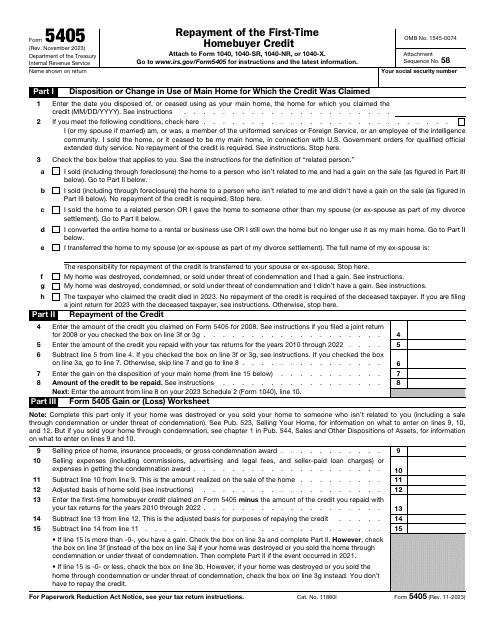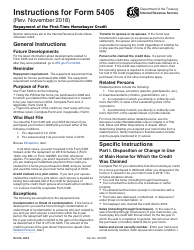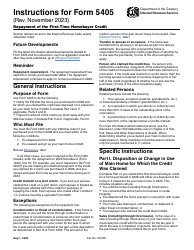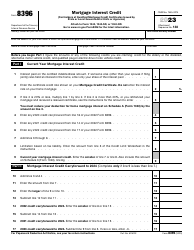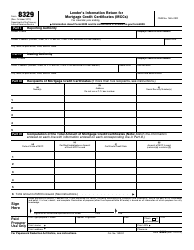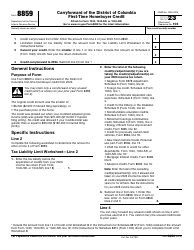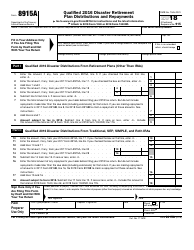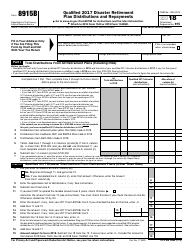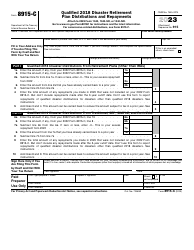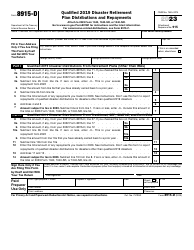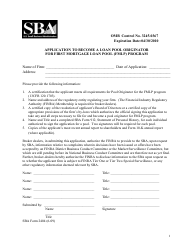IRS Form 5405 Repayment of the First-Time Homebuyer Credit
What Is IRS Form 5405?
IRS Form 5405, Repayment of the First-Time Homebuyer Credit , is a fiscal instrument used by taxpayers who are responsible for computing and repaying the credit they used to purchase residential property in the past.
Alternate Names:
- Tax Form 5405;
- First-Time Homebuyer Form.
If you got rid of your home over the course of the year outlined in your income statement and supplemental tax documentation, you must inform the authorities about the details of the disposition and show the amount of credit you owe.
This document was released by the Internal Revenue Service (IRS) on November 1, 2023 , making previous editions of the form obsolete. You can find an IRS Form 5405 fillable version via the link below.
What Is Form 5405 Used For?
Prepare and submit Tax Form 5405 to let tax organizations know the real estate you have been using as your main residence since 2008 is no longer your home if you filed a claim for a tax credit in the past. Additionally, this statement will help you figure out how much credit you are obliged to pay back when filing your annual income statement.
Only taxpayers that stopped using the real estate to permanently reside in at any point during the tax year described in the form have to complete this instrument; spouses that claimed the credit together are permitted to use half of the credit each. There are certain exceptions to a general rule - if the individual that initially filed a claim for a credit died, your spouse or former partner now owns this place, or you had to deal with the destruction of the property or its inhabitable condition, you are not required to pay the credit back.
Form 5405 Instructions
The IRS Form 5405 Instructions are as follows:
-
Write down your name and social security number . Remember that the name you indicate in this document has to match the one you include on your tax return. State the date when the disposition of the residential property (alternatively, the date when you stopped using this place as your principal residence) occurred.
-
If you were or are working for an intelligence community, uniformed services, or diplomatic service, you have to check the box to confirm your status - additionally, you need to certify whether you got rid of your home or stopped residing there the majority of the time because you were placed on extended duty serving far from your residence or living in the quarters provided to you by the government. Both of these categories include the taxpayer that identified themselves in the form as well as their spouse. In case two definitions describe your situation, you are not required to deal with the credit repayment.
-
Elaborate on what happened to your home by checking the appropriate box - you either sold it to someone with a gain or without it, sold the property to a person related to you or someone else who is not your current spouse, left the home to your spouse or former partner to settle your divorce, simply stopped using this real estate as your primary residence, or utilized the home for business purposes or as a rental. If the home now belongs to the person you used to be married to, identify them in writing. You may also confirm the home was declared uninhabitable, destroyed, or disposed of due to potential unsuitability for occupancy - with or without financial gain - or inform the authorities the individual that requested the credit passed away during the previous year. Note that additional instructions for IRS Form 5405 listed after certain conditions exempt the taxpayer from dealing with the repayment - make sure you comply with the rules.
-
Calculate the credit - state how big the credit was on the first repayment form you filled out as well as on subsequent forms you filed, use the formulas provided in the document, and indicate how much you have gained after disposing of the real property. Replicate the amount in question on Schedule 2 you attach to your tax return.
-
Complete the last section of the form if the home no longer exists because of destruction or you sold it to an individual who is not related to you . This worksheet will inform the IRS about the value of the property, proceeds you received from your insurance company, selling costs, and adjustments made during the credit repayment.
Where to Mail IRS Form 5405?
Once Tax Form 5405 is ready, you need to submit it to tax organizations alongside the income statement you file.
Whether you are filing IRS Form 1040, U.S. Individual Income Tax Return, IRS Form 1040-SR, U.S. Tax Return for Seniors, IRS Form 1040-NR, U.S. Nonresident Alien Income Tax Return, or IRS Form 1040-X, Amended U.S. Individual Income Tax Return, mail IRS Form 5405 with it.
